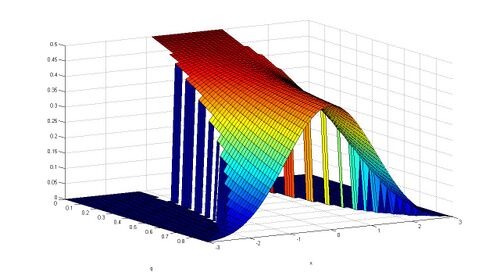Gaussian q-distribution
In mathematical physics and probability and statistics, the Gaussian q-distribution is a family of probability distributions that includes, as limiting cases, the uniform distribution and the normal (Gaussian) distribution. It was introduced by Diaz and Teruel.[clarification needed] It is a q-analog of the Gaussian or normal distribution.
The distribution is symmetric about zero and is bounded, except for the limiting case of the normal distribution. The limiting uniform distribution is on the range -1 to +1.
Definition

Let q be a real number in the interval [0, 1). The probability density function of the Gaussian q-distribution is given by
where
The q-analogue [t]q of the real number is given by
The q-analogue of the exponential function is the q-exponential, Exq, which is given by
where the q-analogue of the factorial is the q-factorial, [n]q!, which is in turn given by
for an integer n > 2 and [1]q! = [0]q! = 1.

The cumulative distribution function of the Gaussian q-distribution is given by
where the integration symbol denotes the Jackson integral.
The function Gq is given explicitly by
where
Moments
The moments of the Gaussian q-distribution are given by
where the symbol [2n − 1]!! is the q-analogue of the double factorial given by
See also
References
- Díaz, R.; Pariguan, E. (2009). "On the Gaussian q-distribution". Journal of Mathematical Analysis and Applications 358: 1–9. doi:10.1016/j.jmaa.2009.04.046.
- Diaz, R.; Teruel, C. (2005). "q,k-Generalized Gamma and Beta Functions". Journal of Nonlinear Mathematical Physics 12 (1): 118–134. doi:10.2991/jnmp.2005.12.1.10. Bibcode: 2005JNMP...12..118D. http://staff.www.ltu.se/~norbert/home_journal/electronic/121art6.pdf.
- van Leeuwen, H.; Maassen, H. (1995). "A q deformation of the Gauss distribution". Journal of Mathematical Physics 36 (9): 4743. doi:10.1063/1.530917. Bibcode: 1995JMP....36.4743V. http://www.math.ru.nl/~maassen/preps/qGauss.pdf.
- Exton, H. (1983), q-Hypergeometric Functions and Applications, New York: Halstead Press, Chichester: Ellis Horwood, 1983, ISBN:0853124914, ISBN:0470274530, ISBN:978-0470274538
 |

